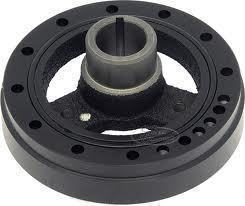 In a regular oven, a thin layer of air insulates food from the heat beneath it. This layer of air causes food to be cooked unevenly and slows cooking time down considerably. A convection oven is a type of oven that solves this problem by circulating the air within the chamber by using either one or two fans that are located below the heating element. Convection ovens cause food to be cooked quickly and thouroughly without being burnt and use less electricity than conventional ovens. This article will explain how a convection oven works and will list the various parts of this device.
In a regular oven, a thin layer of air insulates food from the heat beneath it. This layer of air causes food to be cooked unevenly and slows cooking time down considerably. A convection oven is a type of oven that solves this problem by circulating the air within the chamber by using either one or two fans that are located below the heating element. Convection ovens cause food to be cooked quickly and thouroughly without being burnt and use less electricity than conventional ovens. This article will explain how a convection oven works and will list the various parts of this device.
How Does A Convection Oven Work
A convection oven works in much the same way as a conventional oven. Food is placed on a metal rack inside the chamber and a heating element heats the air inside of the chamber which causes a hot layer of air to build up around the food. The difference between a convection oven and a conventional oven is that a convection oven includes a built-in fan underneath the heating element that creates a flow of hot air in the chamber rather than building up a hot layer. There are varying models of convection ovens but most are built in a similar fashion.
Inner Housing
The inner housing, or chamber, of a convection oven is a large, enclosed container in which food is placed. The inner housing of a convection oven often includes one or two racks in addition to a rotisserie rack as convection ovens provide an ideal cooking environment for roasted meats. Because convection ovens have lower heat and shorter cooking times, there is less food shrinkage than conventional ovens. This means that more food can be placed in the oven at one time and more food is left over when the meal is cooked. Convection ovens range in size and can be as small as a microwave oven or as large as a conventional oven.
Heating Element
While conventional ovens have a heating element on the top and bottom, convection ovens have a heating element on the top, bottom, and rear of the inner housing. In addition to the circulating air caused by the fan, these three heating elements work together to provide a thorough source of heat throughout the inner housing. This means that food is cooked evenly whether it is placed on the bottom, middle, or top rack. Heating elements inside a convection oven are often made of nickel wires covered in a ceramic binder and sealed inside of a steel or brass tube.
Impeller
An impeller is a type of cylindrical fan that blows hot air throughout a convection oven. Impellers work by letting air into the open center and then propelling it outward by using a number of "vanes" that repeatedly spin in a constant direction. Impellers come in many different sizes and are used for a wide variety of applications but all work in a similar fashion. In fact, an impeller is simply a propeller without the blades.




USMCVAG
What I believe everyone wants to know (or should want to know) is why and when the top and bottom heating elements
light. I performed a few tests to better understand how my convection toaster oven works.
A. DIAL SET TO BAKE. Top heating element is OFF. Bottom heating element is ON. Fan is ON.
B. DIAL SET TO BROIL. Top heating element is ON. Bottom heating element is OFF. Fan is OFF.
C. DIAL SET TO TOAST. Top heating element is ON. Bottom heating element is ON. . Fan is OFF.
Is the above description correct?????? Whether YES or NO, please explain.
If convection is so good why doesn’t the fan turn on in ALL DIAL settings?…or should it? Please explain.
Thanks. Regards, Vince G.